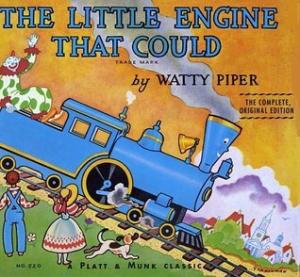Good message, boring story.

It's not a bad story, it's just really dated. This book has been around for eons, and it's been re-illustrated, so I wanted to go back and look at the "original", which is tough as apparently the original wasn't a picture book. But this version is the original picture book, and it says "retold" because they felt it was part of American folklore by the time they wrote it down.
There's a red train who is pulling a load of toys and food for the children on the other side of the mountain. She's just chugging along and then suddenly she stops (it doesn't explain why) and can't move anymore. The toys, who are apparently alive (the train doesn't appear to have a driver, a la Thomas the Tank Engine) ask other passing trains for help. I'm not sure why the broken train doesn't speak for herself, perhaps the opposing tracks are too far away from each other. A yellow train comes by, a Shiny New Engine, and says, "I pull you? I am a Passenger Engine. I have just carried a fine big train over the mountain, with more cars than you ever dreamed of. My train had sleeping cars, with comfortable berths; a dining-car where waiters bring whatever hungry people want to eat; and parlor cars in which people sit in soft arm-chairs and look out of big plate-glass windows. I pull the likes of you? Indeed not!" So all the toys are sad. The next train comes by and says, "I am a Freight Engine. I have just pulled a big train loaded with big machines over the mountain. These machines print books and newspapers for grown-ups to read. I am a very important engine indeed. I won't pull the likes of you!" Another train comes by, but it's too old and tired, so it can't pull anyone else, rumbling off saying, "I can not. I can not." Then a little blue engine comes by and stops when it sees the toys and asks what the problem is. They ask if the blue engine can pull the cars, and it says, They use me only for switching trains in the yard. I have never been over the mountain." But it decides to try, saying, I think I can. I think I can. I think I can." as it goes over the mountain, and successfully makes it over the mountain, saying, "I thought I could. I thought I could." And that's the end of the book.
Despite the twin messages of "It's good to help others" and "Believe in yourself," the book doesn't really go anywhere. There's a problem at the beginning, and when the problem is solved, it's over. I remember bits and pieces of this from my childhood, like these apples and oranges that have really bizarre faces on them is very striking to me. And I can't help wondering if it's intentional that the three trains that refuse to help the red train are all male, depicted as "he" and using male pronouns, whereas the red train who has the problem and the blue train who helps are both female. The author was actually male, using a pen name. I'm not sure it's a coincidence, but I'm not really sure what it means. Maybe it's suggesting that females are more likely to help others because they're more compassionate? But it also kind of implies that men think that they're above helping women out. It's just really a product of its time. I'm pretty sure it's not interesting enough for most of today's kids. There's gratitude in it, which is nice. There's helping others, which is nice. There's believing in yourself, which is nice. But it's really not that much more interesting than "The Little Red Caboose" except that it's got female trains in it. I think "The Little Engine That Could" is probably the most popular fictional female train. Thomas the Tank Engine just doesn't have enough female characters, despite her popularity. It's not bad for the time period in which it was written, especially compared to most of the other books from the 1930s, but it doesn't really hold up to modern books.